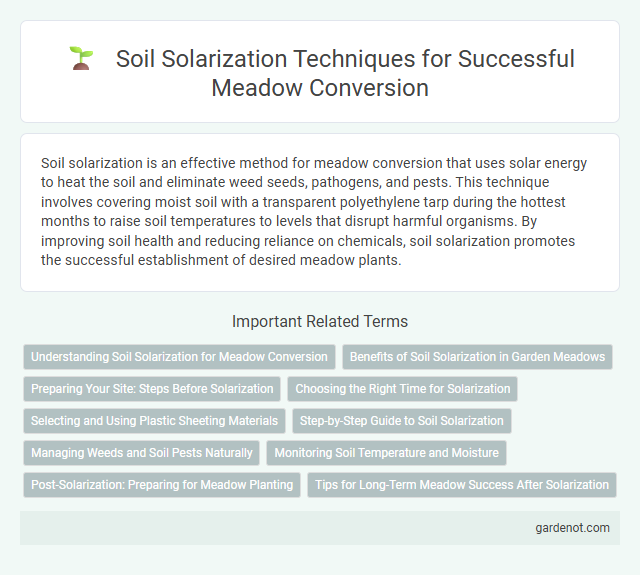Soil solarization is an effective method for meadow conversion that uses solar energy to heat the soil and eliminate weed seeds, pathogens, and pests. This technique involves covering moist soil with a transparent polyethylene tarp during the hottest months to raise soil temperatures to levels that disrupt harmful organisms. By improving soil health and reducing reliance on chemicals, soil solarization promotes the successful establishment of desired meadow plants.
Understanding Soil Solarization for Meadow Conversion
Soil solarization is a non-chemical method that uses solar energy to heat the soil, effectively controlling weeds, pests, and soil-borne diseases before meadow conversion. Transparent polyethylene sheets are laid over moist soil for 4 to 6 weeks during peak summer, raising soil temperatures to 45-60degC, which disrupts harmful pathogens and seed banks. This environmentally friendly technique enhances soil health and prepares the ground for establishing a thriving, sustainable meadow ecosystem.
Benefits of Soil Solarization in Garden Meadows
Soil solarization in garden meadows enhances soil health by using solar energy to elevate soil temperatures, effectively reducing soil-borne pathogens, weeds, and nematodes. This eco-friendly method improves nutrient availability and increases microbial activity, fostering robust plant growth and higher biodiversity. As a sustainable pest management technique, soil solarization promotes healthier, more resilient garden meadows without chemical inputs.
Preparing Your Site: Steps Before Solarization
Preparing your site for soil solarization involves thoroughly clearing the meadow of existing vegetation and debris to maximize sun exposure and heat retention. Tilling the soil to a depth of 6 to 12 inches breaks up compact layers, facilitating better heat penetration and microbial activity. Moistening the soil prior to covering it with clear plastic enhances thermal conductivity, increasing the effectiveness of solarization against soil-borne pests and weed seeds.
Choosing the Right Time for Solarization
Soil solarization is most effective during the hottest months, typically between late spring and early summer when soil temperatures reach 45-60degC (113-140degF) for several consecutive weeks. Choosing the right time ensures maximum heat penetration to eliminate soil pathogens, weed seeds, and nematodes, improving meadow conversion success. Monitoring local climate data and ensuring consistent sun exposure optimizes soil solarization outcomes.
Selecting and Using Plastic Sheeting Materials
Selecting high-quality, UV-resistant plastic sheeting is crucial for effective soil solarization in meadow conversion, as it maximizes heat retention and durability during the treatment period. Clear polyethylene sheeting with a thickness of 1 to 4 mils ensures optimal sunlight penetration and soil warming, accelerating the eradication of weeds, pests, and soil-borne pathogens. Proper installation involves securely anchoring the edges to prevent heat loss and moisture escape, enhancing the overall efficiency of the soil solarization process.
Step-by-Step Guide to Soil Solarization
Soil solarization involves covering moist soil with transparent plastic sheets during the hottest months to trap solar energy, raising temperatures to lethal levels for soil-borne pests and weeds. Start by clearing the meadow surface, tilling the soil to a fine texture, and thoroughly irrigating it to enhance heat conduction. Secure the plastic sheeting tightly over the soil for 4 to 6 weeks, ensuring edges are buried to maintain heat and maximize pathogen eradication.
Managing Weeds and Soil Pests Naturally
Soil solarization uses solar energy to elevate soil temperatures, effectively managing weeds and soil pests naturally by disrupting their life cycles. This eco-friendly method reduces reliance on chemical herbicides and pesticides, promoting healthier meadow conversion processes. Studies show that soil solarization can decrease weed seed banks and soil-borne pathogens by up to 90%.
Monitoring Soil Temperature and Moisture
Monitoring soil temperature and moisture during soil solarization is critical to ensure effective weed and pathogen control in meadow conversion projects. Maintaining soil temperatures between 40degC and 55degC for 4 to 6 weeks maximizes microbial suppression and organic matter mineralization. Regular moisture assessments help retain adequate soil wetness, improving heat conductivity and enhancing solarization efficacy.
Post-Solarization: Preparing for Meadow Planting
Post-solarization soil preparation involves carefully loosening compacted soil to enhance aeration and root penetration for optimal meadow planting. Incorporating organic matter such as compost improves soil fertility and microbial activity, promoting healthy growth of native meadow species. Monitoring soil moisture ensures adequate hydration, supporting seed germination and establishment in the newly solarized meadow area.
Tips for Long-Term Meadow Success After Solarization
Soil solarization effectively reduces soil-borne pathogens and weed seeds, setting a strong foundation for a healthy meadow. To ensure long-term success, maintain proper irrigation, avoid excessive foot traffic during establishment, and incorporate native species adapted to local soil conditions. Regular monitoring and periodic soil testing help sustain nutrient balance and promote resilient meadow growth after solarization.
Soil solarization Infographic

 gardenot.com
gardenot.com